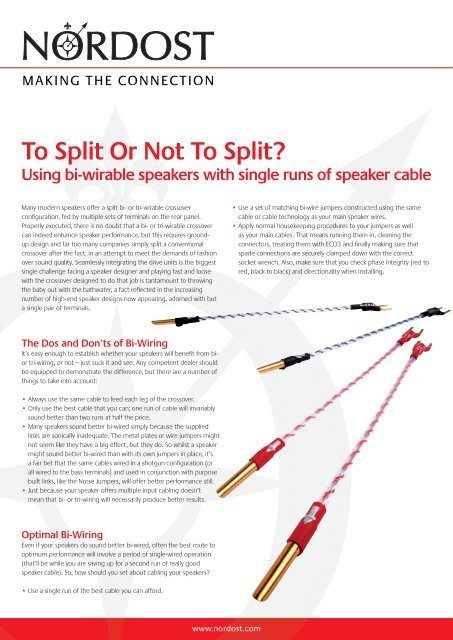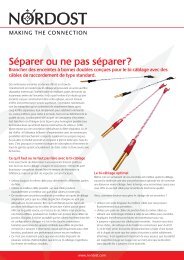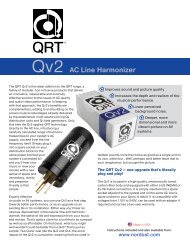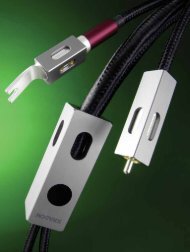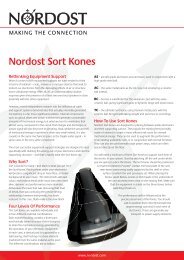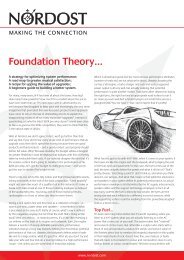Norse Jumper Instructions - Nordost
Norse Jumper Instructions - Nordost
Norse Jumper Instructions - Nordost
You also want an ePaper? Increase the reach of your titles
YUMPU automatically turns print PDFs into web optimized ePapers that Google loves.
To Split Or Not To Split?<br />
Using bi-wirable speakers with single runs of speaker cable<br />
Many modern speakers offer a split bi- or tri-wirable crossover<br />
confi guration, fed by multiple sets of terminals on the rear panel.<br />
Properly executed, there is no doubt that a bi- or tri-wirable crossover<br />
can indeed enhance speaker performance, but this requires groundup<br />
design and far too many companies simply split a conventional<br />
crossover after the fact, in an attempt to meet the demands of fashion<br />
over sound quality. Seamlessly integrating the drive units is the biggest<br />
single challenge facing a speaker designer and playing fast and loose<br />
with the crossover designed to do that job is tantamount to throwing<br />
the baby out with the bathwater, a fact refl ected in the increasing<br />
number of high-end speaker designs now appearing, adorned with but<br />
a single pair of terminals.<br />
The Dos and Don’ts of Bi-Wiring<br />
It’s easy enough to establish whether your speakers will benefi t from bi-<br />
or tri-wiring, or not – just suck it and see. Any competent dealer should<br />
be equipped to demonstrate the difference, but there are a number of<br />
things to take into account:<br />
• Always use the same cable to feed each leg of the crossover.<br />
• Only use the best cable that you can; one run of cable will invariably<br />
sound better than two runs at half the price.<br />
• Many speakers sound better bi-wired simply because the supplied<br />
links are sonically inadequate. The metal plates or wire jumpers might<br />
not seem like they have a big effect, but they do. So whilst a speaker<br />
might sound better bi-wired than with its own jumpers in place, it’s<br />
a fair bet that the same cables wired in a shotgun confi guration (or<br />
all wired to the bass terminals) and used in conjunction with purpose<br />
built links, like the <strong>Norse</strong> <strong>Jumper</strong>s, will offer better performance still.<br />
• Just because your speaker offers multiple input cabling doesn’t<br />
mean that bi- or tri-wiring will necessarily produce better results.<br />
Optimal Bi-Wiring<br />
Even if your speakers do sound better bi-wired, often the best route to<br />
optimum performance will involve a period of single-wired operation<br />
(that’ll be while you are saving up for a second run of really good<br />
speaker cable). So, how should you set about cabling your speakers?<br />
• Use a single run of the best cable you can afford.<br />
www.nordost.com<br />
• Use a set of matching bi-wire jumpers constructed using the same<br />
cable or cable technology as your main speaker wires.<br />
• Apply normal housekeeping procedures to your jumpers as well<br />
as your main cables. That means running them in, cleaning the<br />
connectors, treating them with ECO3 and fi nally making sure that<br />
spade connections are securely clamped down with the correct<br />
socket wrench. Also, make sure that you check phase integrity (red to<br />
red, black to black) and directionality when installing.
Wiring Confi gurations<br />
The correct wiring confi guration for a bi-wiring arrangement can be<br />
readily established by experimentation, but in general, the best results<br />
will be obtained as follows:<br />
Connect the jumpers from the bass/mid terminals to the treble terminals,<br />
following the guidance outlined above. Then connect the speaker wires<br />
to the bass/mid terminals. This should be your default set up, generally<br />
offering the greatest rhythmic integrity and mid-band clarity.<br />
Very occasionally the reverse arrangement, connecting to the treble<br />
terminals can produce superior results. This is rare, but worth trying,<br />
especially where exotic or hard to drive tweeters are employed.<br />
Often, the very best results are achieved using a diagonal connection.<br />
This involves connecting the red cable to the bass/mid terminal and<br />
the black to the treble, with the jumpers arranged accordingly, bass to<br />
treble on the red (or +ve) side of the crossover, treble to bass on the<br />
black (or -ve) side. This is slightly more confusing to wire, however, with<br />
a little extra care and patience the results can be well worthwhile, and<br />
once you are familiar with bi-wiring procedures this often becomes the<br />
new default set up, offering greater air, transparency, dimensionality<br />
and subtlety.<br />
www.nordost.com
Although increasingly rare, you may also come across tri-wired speaker<br />
designs. The same basic procedure applies, although in this instance<br />
the best connection is almost invariably to the midrange terminals.<br />
Once again, use jumpers, but in this instance two pairs per speaker with<br />
directionality maintained, outwards from the midrange connection<br />
(ie. One jumper running mid to treble, the other mid to bass). Again,<br />
take great care over directionality and phase coherence.<br />
Finally, most jumpers are supplied with a spade on the send-end and<br />
either a spade or 4mm plug on the destination-end. <strong>Norse</strong> <strong>Jumper</strong>s<br />
run from a spade to the 4mm Z-plug, however, if it is more convenient<br />
(for instance, if your speaker cables use spade terminations) other<br />
confi gurations can be ordered: 4mm to 4mm, spade to spade or any<br />
other termination you may require. Your dealer, <strong>Nordost</strong> distributor or<br />
<strong>Nordost</strong> Customer Service can advise.<br />
<strong>Nordost</strong> Corporation 200 Homer Avenue Ashland MA 01721 USA<br />
Tel: +1 508 881 1116 Fax: +1 508 881 6444 Email: info@nordost.com Website: www.nordost.com<br />
www.nordost.com


